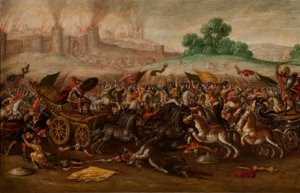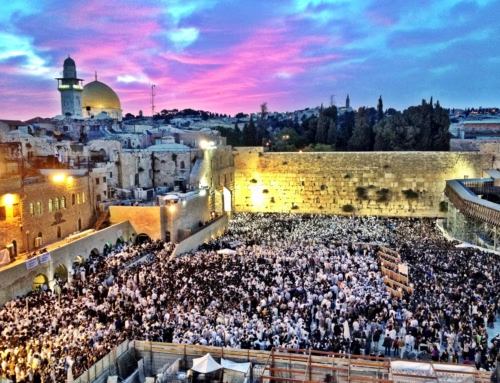Shiva Asar B’tammuz
The seventeenth day of the fourth month, Tammuz, is a Jewish fast in memory of the breach of Jerusalem’s walls before the destruction of the Second Temple. The day marks the beginning of a three-week period of mourning leading up to Tisha B’Av, a holiday that calls to remembrance the destruction of the Temple in Jerusalem and the exile from Israel.

Nebuchadnezzar’s army burns down Jerusalem around 600 BCE. During the Babylonian siege of Jerusalem, the daily offering ceased because no sheep were available. The painting is from the 17th century and comes from someone in the circle around the artist Juan de la Corte.
Shiva Asar B’Tammuz, which this year falls on July 13 according to the Gregorian calendar, also traditionally commemorates the breaking of the two tablets of the Ten Commandments and other historical tragedies that have befallen the Jewish people on this day.
According to Rabbi Akiva (who lived around 50–135 CE), the Tammuz fast is the one mentioned in the Book of Zechariah as “the fast of the fourth [month]” (Zechariah 8:19).
According to the Mishnah, compiled around 200 AD and the first major written collection of Jewish oral traditions, several calamities befell the Jewish people on this very day: In addition to Moses shattering the two stone tablets on Mount Sinai upon seeing the golden calf, and the breaching of the city walls during the Roman siege of Jerusalem (which led to the destruction of the Second Temple on Tisha B’Av), the Roman military commander Apostomus is also said to have burned a Torah scroll on this date shortly before the Bar Kokhba revolt.
Shattered Tablets
The seventeenth of Tammuz also commemorates the Babylonian siege of Jerusalem, when the daily offering ceased because no sheep were available. The holiday occurs forty days after the Jewish holiday of Shavuot, when Moses ascended Mount Sinai and stayed there for forty days. During this period, the children of Israel made the golden calf (on the sixteenth of Tammuz) when it seemed Moses would not return. When Moses came down the next day (forty days after Shavuot) and saw the Israelites’ idolatry, which broke the laws he had just received from God, he smashed the stone tablets on the ground.
The fast day lasts from dawn until shortly after sunset. Some Jews refrain from listening to music, attending public entertainment, or cutting their hair on this fast day.
The seventeenth of Tammuz is the second of the four fasts that commemorate the destruction of the Temple and the Jewish exile. The first fast, the tenth of Tevet, marks the anniversary of the siege of Jerusalem in 588 BCE (in the Gregorian calendar, the tenth of Tevet falls sometime in December or January).
Exile and Loss of Autonomy
The 17th of Tammuz occurs three weeks before the full-day fast on the Ninth of Av and is also historically linked to the Fast of Gedaliah, observed on the third day of Tishrei—the day after Rosh Hashanah, the Jewish New Year. The assassination of Gedaliah (2 Kings 25:25), who had been appointed governor of Judah by the Babylonians after the destruction of the First Temple, led to further exile and loss of self-rule for the Jewish people.
The three weeks from the 17th of Tammuz to the 9th of Av are known as Bein haMetzarim (“between the straits” or “the narrow places,” i.e., between days of distress). This period of mourning is also simply called “The Three Weeks.”
The earliest preserved reference to these days as Bein haMetzarim is found in Eikhah Rabbati, a commentary on the Book of Lamentations from the Talmudic period, likely compiled in the fourth century AD. Lamentations 1:3 reads, “All her [Zion’s] pursuers overtook her between the straits.” In other translations, this is rendered as “… in her distress.”



